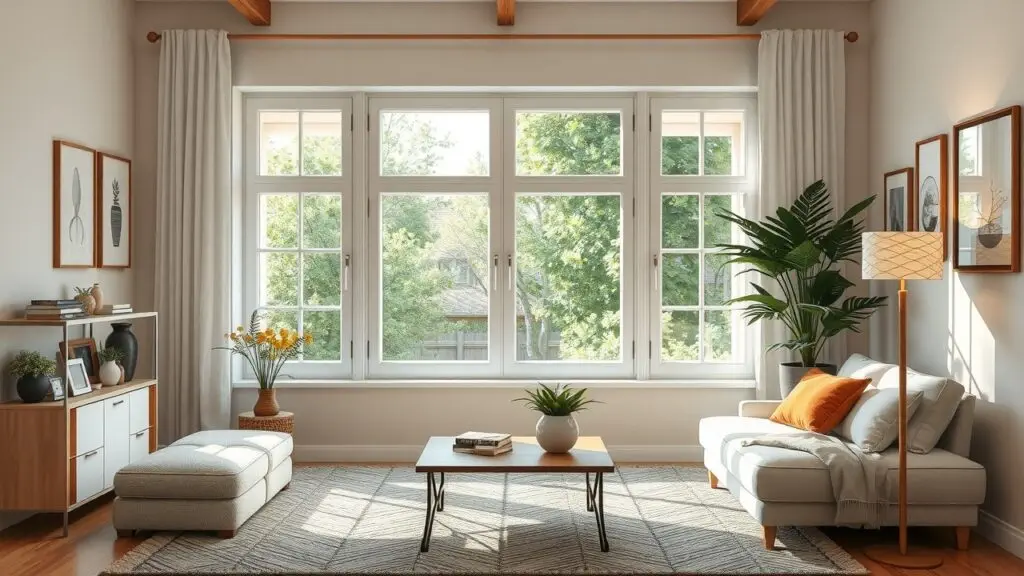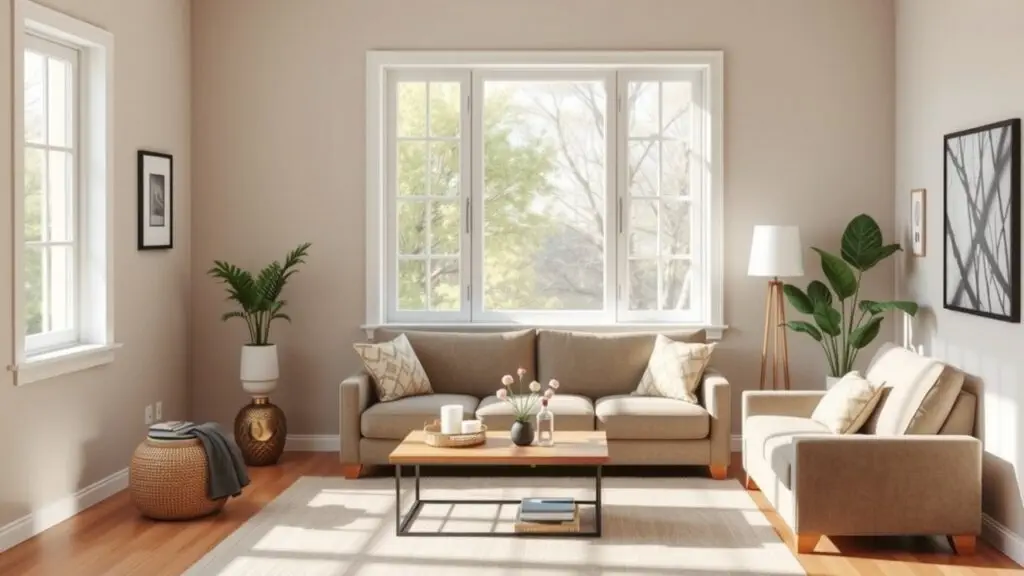Types of living room windows greatly impact your home’s style and natural light. Explore bay, bow, casement, and other window types to find the perfect fit, considering size, style, and view.
What Are Living Room Windows?

Living room windows are key parts of a home’s design. They let in natural light, provide fresh air, and frame views of the outdoors. The right type of window can change the whole feel of a living room, making it look more inviting and spacious.
Why Do They Matter?
Choosing the best living room windows is super important. First off, different types of living room windows can change how a room looks. For instance, modern windows might fit well in a sleek design, while traditional windows may suit a cozy setting. Also, larger windows can brighten up dim areas, giving your space an airy vibe. Plus, good ventilation is vital for keeping air fresh indoors; some window styles allow for better airflow than others.
Energy efficiency is another big deal when picking windows. Well-made options can help cut down heating and cooling costs by keeping heat inside during winter and keeping homes cool in summer. And don’t forget about views! Large living room windows can connect you with nature and even boost your home’s value.
This guide will cover common living room window styles, such as double-hung, casement, bay, picture windows, and sliding glass doors. Each style comes with its own perks that fit various needs for looks and practical use like energy savings or airflow.
Double-Hung Windows for Living Rooms
Double-hung windows are a popular choice for living rooms, especially in traditional homes. They have two sashes that slide up and down. This design allows for good ventilation, as you can open both the top and bottom sashes. Many homeowners love their classic look and ease of use, making them some of the best window styles out there.
Pros and Cons of Double-Hung Windows
Pros:
- Ventilation Control: You can open both sashes for fresh air.
- Easy Cleaning: Both sashes tilt inward, which makes cleaning safe and simple.
- Energy Efficiency: Modern double-hung windows often feature low-E glass and insulated frames.
Cons:
- Maintenance Needs: Older wooden versions may need regular painting or staining to avoid rot.
- Air Leakage Potential: If not sealed properly, they might let in drafts over time.
Double-hung windows work well with various home styles while letting in lots of natural light. They come in different sizes, so you can choose large ones for great views or smaller ones to fit your design.
Casement Windows Explained
Casement windows are hinged on one side and swing open outward. This design is great for maximizing airflow in living rooms. They look modern and fit well in contemporary homes. Plus, they offer great energy efficiency since they seal tightly when closed.
Benefits of Casement Windows
- Maximizing Airflow: They open all the way to catch breezes effectively.
- Energy Efficiency: The tight seal reduces heat loss when it’s cold outside.
- Unobstructed Views: With no central muntin bars, you get clear views outdoors.
Make sure to think about where you place casement windows since they swing outwards. This might limit space on patios or walkways.
Sliding Windows Overview
Sliding windows have two or more sashes that slide horizontally along tracks. They’re a great choice if you want wide views without taking up wall space. This makes them ideal for large living room openings where panoramic views are desired.
Key Features
- Wide Views: Sliding windows can have larger panes compared to others.
- Space-Saving Design: Unlike casements or awning styles that stick out when opened, sliding windows stay flush with walls.
These contemporary window styles help bring in natural light while keeping a sleek look that’s perfect for modern interiors.
Awning Windows: Protection and Ventilation
Awning windows are hinged at the top and open from the bottom edge. This design allows for sheltered ventilation even during rainstorms, which is handy if you live in an area with unpredictable weather.
Advantages
- Sheltered Ventilation: Rainwater runs off when these windows are slightly open.
- Enhanced Privacy & Light Control: Placed higher on walls, they offer privacy while still letting in light.
Awning windows work well above doors or next to fixed units where you want airflow without losing style.
Bay & Bow Windows: Expanding Space and Light
Bay and bow windows extend beyond the exterior walls, creating a cozy nook inside your living room. They’re perfect if you want more seating space along with increased sunlight throughout the day!
Key Features
| Feature | Bay Window | Bow Window |
|---|---|---|
| Shape | Angular (usually three sections) | Curved (four or more sections) |
| Space Created | More defined alcove | Gentle curve adds depth |
| Aesthetic Appeal | Traditional charm | Soft elegance |
Both bay and bow windows invite plenty of natural light into any space while enhancing visual appeal from the outside too!
Fixed (Picture) Windows: Maximizing Views
Fixed picture windows do not open but serve as large panes meant to showcase outdoor scenes without any framing blocking your view!
Benefits
- Unobstructed Views: Ideal spots include overlooking gardens or landscapes for maximum visibility!
- Natural Light Enhancement: Their size lets sunlight pour into rooms, brightening up your space!
When looking at types of living room windows that focus on looks while being functional—fixed picture variants truly shine!
Choosing the Right Material: Vinyl, Wood, Fiberglass, and More
When picking windows for your home, the material matters a lot. It affects how they look, how well they keep your house warm or cool, how much care they need, and what they cost. Here’s a breakdown of popular window materials to help you choose wisely.
Vinyl Windows
Vinyl windows are a popular choice because they’re cheap and easy to take care of. They don’t fade or warp easily from bad weather. The pros of vinyl windows include great insulation that helps save on heating and cooling costs. But the cons are that there are fewer color choices than wood or fiberglass windows. The cost of vinyl windows usually runs from $300 to $800 per window, depending on size and style.
Cleaning them is super easy—just soap and water do the trick. If you go for energy-efficient models, they often have double or triple glazing to keep your home cozy.
Wood Windows
Wood windows bring a classic charm and warmth that many love. Their pros include excellent insulation, making them good for energy efficiency in wooden frames. Plus, you can paint or stain them any color you like! On the downside, wood needs regular upkeep—like painting or sealing every few years—to stop it from rotting or getting bugs.
The cost of wood windows is usually between $800 to $1,200 each, based on quality and craftsmanship. While they can be pricier than vinyl options at first, their beauty can add real value to your home if you take care of them.
Fiberglass Windows
Fiberglass windows are becoming more popular thanks to their strength and ability to handle extreme temperatures without warping like some other materials do. The main pros are their durability and good insulation, which gives them better energy efficiency certifications compared to traditional materials like aluminum.
However, these can come with higher upfront costs—around $600 to $1,500 each—depending on how customized you want them! For maintenance? Just check them regularly and clean with mild detergent.
Aluminum Windows
Aluminum frames look modern while being light but strong enough for larger openings without losing stability. Its advantages include sleek designs that fit well in contemporary homes and lower price points around $400 to $900 each (price varies based on specifics).
But there are downsides too! These frames can let heat escape unless they have thermal breaks, which could lead to higher bills in winter or summer! For maintenance? Just wash them occasionally but keep an eye out for corrosion if not treated properly!
Energy-efficient features in some aluminum designs help them compete with other options we talked about here today.
Composite Windows
Composite windows mix different materials together, offering the benefits from various kinds while reducing weaknesses found in pure types! The benefits include improved durability and attractive finishes at competitive prices ranging from mid-range ($700-$1200) all the way up for luxury brands based on market presence!
Some drawbacks involve limits on customizability compared to solid wood options; however, advances continue to improve choices available now!
Choosing the right window material depends on your tastes balanced with practical factors like budget and long-term plans for your living space!
Optimizing Your Living Room with Strategic Window Placement

Strategic window placement can really boost the look and feel of your living room. The right windows let in more light, improve airflow, and create a warm vibe. Knowing how different living room window designs fit into your space helps you choose wisely.
Impact of Window Size on Room Proportions and Sunlight
Window dimensions matter a lot for how your living room feels. Big windows can make a small space seem larger and brighter by letting in lots of natural light. This is super helpful in cozy rooms that might feel cramped.
On the flip side, small living room windows can keep things private while controlling glare from the sun. Energy-efficient windows come in different sizes to fit both looks and needs; they often have double or triple glass layers for better insulation while still looking good.
When picking window size, think about how much light you want at various times of day. Bigger impact windows not only offer great views but also bring plenty of daylight, lighting up dark spots in your room.
Optimal Window Placement for Maximizing Views and Light
The best living room windows should be placed thoughtfully to showcase views and let in light. Setting large picture windows to face beautiful landscapes not only frames lovely views but also brings tons of natural sunlight into your home.
You might want to place casement or double-hung windows close to seating areas for better airflow when they’re open—this helps keep the air fresh without hiding those pretty sights. Bay or bow windows stick out from walls, creating sunny spots perfect for reading or displaying plants.
Balancing Natural Light with Privacy
While getting plenty of sunlight is key, it’s also important to think about privacy. Privacy windows come with features like frosted glass or built-in shades that let in light but keep prying eyes away—this is great if you live near other homes.
Living room window treatments such as sheer curtains or blinds give you control over how much light comes in during the day and help maintain privacy at night without blocking all natural light completely.
Considerations for Different Room Sizes and Layouts
Choosing between small living room windows or larger ones really depends on what you need for your layout:
- Small Living Rooms: Tall, narrow window designs draw the eye up, making the room look taller.
- Large Living Rooms: Having several big panes gives an open feel but may cost more due to installation needs.
Understanding these factors ensures that whether you’re updating a space or starting fresh—you’ll get results that focus on comfort by using window choices effectively!
Understanding Energy Savings
When you think about new windows for your living room, knowing energy savings is super important. Windows can change how your home looks, but they also affect how much energy you use. This can help you save a lot of money on your bills over time.
Return on Investment (ROI) of Energy-Efficient Windows
Getting energy-efficient windows can be a smart choice for your wallet. Many homeowners see an ROI of about 70% to 80% when they switch to high-efficiency options like double or triple-pane windows with Low-E coatings that reflect heat but let in light.
Upgrading to energy-efficient windows lowers monthly heating and cooling bills while boosting your home’s value—great if you’re looking to sell later!
Factors Affecting Window Installation Costs
Installation costs can change based on different factors besides just material prices:
- Window Size: Bigger windows often cost more to install because they need more work.
- Type of Frame: Custom frames might need extra skill, which can raise costs.
- Location: If your house is hard to reach, it might lead to higher fees for installation.
- Removal of Old Windows: Taking out old windows adds extra labor costs before putting in new ones.
Understanding these details helps you budget for both buying the windows and installing them properly.
DIY vs. Professional Installation: Feasibility and Recommendations
Some handy homeowners think about installing their own windows to save cash on labor costs, but it’s usually best to hire pros. Certified installers know how to fit windows right, which is important for any warranties offered by manufacturers if something goes wrong.
So remember, checking out things like NFRC ratings helps make smart choices when picking the right kind of living room windows that will boost comfort at home while also being good investments!
Completing the Look: Treatments and Enhancements
Updating your living room is exciting! One important aspect is the window treatments. They can improve both how your room looks and its functionality. The right coverings can change the feel of your space, while also providing privacy and energy savings.
Choosing the Right Window Treatments: Blinds, Shades, Curtains, Shutters
When picking out living room window coverings, it’s good to know what options you have:
- Blinds are great for controlling light and privacy. They come in materials like wood or vinyl. They fit perfectly in modern spaces.
- Shades include styles like roller shades and Roman shades. They offer a softer look while filtering light nicely. Shades are versatile and go well with many design styles.
- Curtains bring elegance into any room. There are tons of fabrics and patterns available. You can use them alone or layer them with other treatments for a more textured look.
- Shutters are strong and stylish. Made from wood or composite materials, they let you adjust light easily while keeping your home insulated.
Each type has its perks that fit different styles and needs.
Addressing Glare, Privacy, and Energy Efficiency with Window Treatments
Window treatments do more than just look pretty:
- Glare Reduction: Blinds or shades can reduce glare from the sun while still letting some natural light in.
- Privacy Windows: Sheer curtains with blackout liners create a cozy vibe during the day but keep things private at night.
- Energy Efficient Windows: Insulated curtains or cellular shades help keep your home comfy by controlling temperature all year round.
Choosing the right window treatments not only improves comfort but also saves on energy costs!
Decorative Options: Grilles/Muntins, Stained Glass, Window Films
Adding decorative features to your windows gives them character:
- Grilles/Muntins split glass panes into smaller sections. This adds visual interest and fits traditional homes well.
- Stained Glass Windows bring bright colors into your living space. When placed right, they create beautiful light effects inside.
- Window Films offer a budget-friendly way to decorate without making permanent changes. Frosted films give privacy but still let in light.
These enhancements let you express your personal style while making your space more inviting.
Impact of Window Treatments on Room Aesthetics
Choosing living room window design ideas affects how everything else in your home looks:
The right window coverings work well with what you already have. They create a unified theme in your space—whether it’s modern chic or classic style. For example:
Light-colored sheer drapes brighten dark corners, while bold patterned curtains draw attention away from less attractive parts of a room.
Ultimately, selecting the right treatment not only boosts function but also enhances your interior design, making every get-together special!
Maintaining and Protecting Your Investment

Regular Maintenance for Optimal Window Performance
Regular inspections and cleaning are key to keeping your living room windows in good shape. Dust and dirt can build up on the glass and frames, which can lead to problems if not cleaned regularly. A simple clean-up not only makes your windows look better but also helps you catch any cracks or seals that might need fixing. Checking how well the windows open and close is important too. This ensures they work right and help save on energy costs.
Common Window Repair Issues and Solutions
Living room windows often face issues like leaks or drafts from worn-out seals or broken frames. Homeowners usually have to decide between hiring a professional or trying to fix things themselves, depending on their skills. For small repairs, like replacing weather stripping, a DIY fix can save money. But for bigger problems, like changing out a frame, getting a pro is safer to meet building codes.
Safety Considerations: Egress Windows, Child Safety, Security Features
Egress windows are very important for safety during emergencies since they provide an escape route from rooms like basements or bedrooms. Even living rooms can benefit from these features if needed. Securing your living room windows is just as crucial for safety against break-ins. Make sure to install locks on all accessible windows and think about adding features like reinforced glass or alarm systems.
Building Codes and Regulations Regarding Window Installation
When you put in new living room windows or replace old ones, you must follow local building codes. These rules usually cover size limits for egress windows and standards for structural safety. Knowing these regulations can help you avoid expensive mistakes during installation while ensuring everything meets safety requirements in your area.
Frequently Asked Questions (FAQs) About Living Room Windows
What are the most common types of living room windows?
Common types include double-hung, casement, sliding, bay, bow, picture, and garden windows. Each type offers different aesthetics and functionality.
What are the benefits of energy-efficient windows?
Energy-efficient windows reduce heating and cooling costs. They also improve indoor comfort and may increase home value.
How do I choose window placement for my living room?
Consider the view you want to maximize. Place windows near seating areas for ventilation and light access.
What materials are best for living room windows?
Vinyl is low-maintenance and affordable. Wood adds beauty but requires upkeep. Fiberglass is durable while aluminum offers a modern look.
How do window treatments enhance living rooms?
Window treatments control light, add privacy, and improve energy efficiency. Options include blinds, shades, curtains, and shutters.
Additional Topics Related to Living Room Windows
Types of Living Room Window Coverings
- Blinds: Offer light control; suitable for modern homes.
- Shades: Provide softness; great for filtering light.
- Curtains: Add elegance; available in various fabrics.
- Shutters: Combine style with function; good insulation.
Window Functionality and Features
- Ventilation: Consider options that open easily for airflow.
- Insulation: Look for double or triple-pane glass for better energy savings.
- Soundproofing: Choose special designs to reduce noise.
- Security Features: Install locks or reinforced glass for safety.
Decorative Window Options
- Stained Glass: Creates artistic effects with colored light.
- Window Grilles/Muntins: Add character to traditional designs.
- Frosted Films: Provide privacy without blocking light.
Unique Window Shapes
- Arched Windows: Softens corners; adds architectural interest.
- Round Windows: Offer a unique focal point in living spaces.
- Skylight Windows: Bring natural light from above into the room.
Budget Considerations for Windows
- Analyze cost differences between materials like vinyl vs. wood.
- Factor installation costs based on size and complexity.
- Understand long-term savings from energy-efficient models.
Choosing the right types of living room windows involves balancing aesthetics, functionality, and budget considerations to enhance your home’s beauty and comfort.
Related Topics
- Types of window treatments
- Types of window materials
- Types of window coverings
- Types of window shapes
- Types of window functionality
- Types of window security features
- Types of window decorative options



Types of Living Room Windows: Bay, Bow, Casement & More